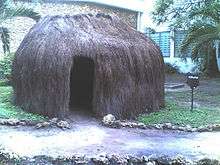Giriama people
 | |
| Total population | |
|---|---|
| 751,531 [1] | |
| Regions with significant populations | |
|
| |
| Religion | |
| African Traditional Religion, Christianity | |
| Related ethnic groups | |
| Mijikenda, other Bantu peoples |
The Giriama (also called Giryama) are one of the nine ethnic groups that make up the Mijikenda (which literally translates to "nine towns").
The Mijikenda occupy the coastal strip extending from Lamu in the north to the Kenya/Tanzania border in the south, and approximately 30 km inland. The Giriama are among the largest of these ethnic groups. They inhabit the area bordered by the coastal cities of Mombasa and Malindi, and the inland towns or Mariakani and Kaloleni.
The Giriama is one of the largest groups of the Mijikenda people in the back-up area of the Northeast coast of Kenya.
Until today, the Giriama extended their living space down to the coast. They are now a big part of service employees in the growing tourism centres. Education programmes initiated by the state included building of central primary schools alongside the coast street. School attendance became compulsory even for girls up to an age of 12 years. The continuous migration of Giriama to places such as Takaungu and Mtwapa allowed them to get access to paid labour, hence they became part of manpower resources, which were once dominated by the Chonyi. The relationship of the Giriama to other Mijikenda groups such as the Ribe, Rabai, Digo and Duruma are rather loose and reserved. The Kamba and Jigana mixed with the coastal population in last decades. Only very few villages could sustain. Also, the Kauma were assimilated. The area around the Kilifi Creek is inhabited by Giriama up to nearly 90 percent.[2]
Their language is called Kigiriama, or Kigiryama, and is a sub-language to the Kimijikenda. The nine Mijikenda groups speak closely related languages, all types of Bantu language, which is the same group to which the more widely known Swahili belongs. The Giriama grow crops to sell and partake in subsistence agriculture.
The Giriama people experience spirit possession. [3]
See also
- Mekatilili Wa Menza, A Giriama woman warrior.
- Malaika Firth (born 1994), fashion model.
References
- ↑ Archived November 21, 2013, at the Wayback Machine.
- ↑ Studies on Musical Diversity – Methodological Approaches, UPM Press, 2011
- ↑ Reluctant Muslims: Embodied Hegemony and Moral Resistance in a Giriama Spirit Possession Janet McIntosh The Journal of the Royal Anthropological Institute, Vol. 10, No. 1 (Mar., 2004), pp.91-112
External links
- "Ethnologue report for language code: nyf, Kigiryama". Ethnologue. Retrieved 2012-08-25.
- Johannes Rebmann (1887). A Nika-English dictionary. Society for Promoting Christian Knowledge. Retrieved 25 August 2012.